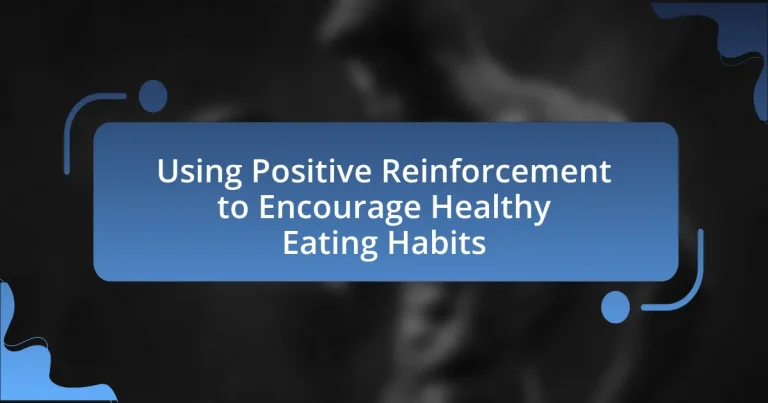The article focuses on the concept of positive reinforcement as a strategy to encourage healthy eating habits. It explains how providing rewards or positive feedback for making healthy food choices can lead to sustained behavior change, supported by psychological principles such as operant conditioning and motivation. Key components of effective positive reinforcement include consistency, specific feedback, and the use of both intrinsic and extrinsic rewards. The article also addresses potential challenges, such as over-reliance on rewards, and offers practical strategies for implementing positive reinforcement in daily life, including goal setting, family involvement, and the use of technology. Overall, it highlights the long-term benefits of positive reinforcement in promoting healthier dietary patterns and improving overall well-being.

What is Positive Reinforcement in the Context of Healthy Eating?
Positive reinforcement in the context of healthy eating refers to the practice of encouraging desirable eating behaviors by providing rewards or positive feedback when individuals make healthy food choices. This approach is grounded in behavioral psychology, where reinforcing specific actions increases the likelihood of those actions being repeated. For example, when a person chooses a salad over a burger and receives praise or a small reward, they are more likely to repeat that healthy choice in the future. Research indicates that positive reinforcement can effectively promote healthier eating habits, as it creates a supportive environment that acknowledges and rewards progress towards better nutrition.
How does positive reinforcement influence behavior change in eating habits?
Positive reinforcement significantly influences behavior change in eating habits by encouraging individuals to adopt healthier choices through rewards or positive feedback. When individuals receive positive reinforcement, such as praise or tangible rewards for making healthy food choices, they are more likely to repeat those behaviors. Research indicates that positive reinforcement can lead to sustained changes in dietary habits, as it creates a favorable association with healthy eating. For example, a study published in the journal “Appetite” found that participants who received rewards for consuming fruits and vegetables increased their intake by 25% compared to those who did not receive any reinforcement. This demonstrates that positive reinforcement effectively motivates individuals to change their eating behaviors towards healthier options.
What psychological principles underpin positive reinforcement?
Positive reinforcement is underpinned by several psychological principles, primarily operant conditioning, motivation, and behavior modification. Operant conditioning, developed by B.F. Skinner, posits that behaviors followed by positive outcomes are more likely to be repeated. This principle is evident in scenarios where individuals receive rewards for healthy eating, thereby increasing the likelihood of maintaining such behaviors. Motivation plays a crucial role, as intrinsic and extrinsic motivators can drive individuals to engage in healthy eating habits when they associate positive reinforcement with their actions. Additionally, behavior modification techniques, which involve systematically reinforcing desired behaviors, further support the effectiveness of positive reinforcement in promoting healthy eating. These principles collectively demonstrate how positive reinforcement can effectively encourage and sustain healthy dietary choices.
How can positive reinforcement be effectively applied to eating habits?
Positive reinforcement can be effectively applied to eating habits by rewarding individuals for making healthier food choices. For instance, when a person chooses a salad over a burger, providing verbal praise or a small treat can reinforce that behavior, making it more likely to occur again. Research indicates that positive reinforcement increases the likelihood of repeating desired behaviors; a study published in the Journal of Nutrition Education and Behavior found that individuals who received rewards for healthy eating were more likely to maintain those habits over time. This approach leverages the psychological principle that behaviors followed by positive outcomes are more likely to be repeated, thus promoting sustained healthy eating habits.
What are the key components of positive reinforcement for healthy eating?
The key components of positive reinforcement for healthy eating include rewards, consistency, and specific feedback. Rewards, such as praise or tangible incentives, encourage individuals to choose healthier food options. Consistency in applying these rewards reinforces the behavior over time, making it more likely to become a habit. Specific feedback helps individuals understand what behaviors are being reinforced, allowing them to recognize their progress and stay motivated. Research indicates that positive reinforcement can significantly improve dietary choices and adherence to healthy eating patterns, as demonstrated in studies focusing on behavior modification techniques in nutrition.
What types of rewards can be used to encourage healthy eating?
Tangible rewards such as gift cards, healthy snacks, or cooking classes can effectively encourage healthy eating. Research indicates that positive reinforcement, including these types of rewards, increases the likelihood of adopting healthier dietary habits. For instance, a study published in the Journal of Nutrition Education and Behavior found that participants who received incentives for healthy eating were more likely to improve their dietary choices compared to those who did not receive rewards.
How do intrinsic and extrinsic rewards differ in promoting healthy eating?
Intrinsic rewards, such as personal satisfaction and improved well-being, differ from extrinsic rewards, like tangible incentives or social recognition, in their approach to promoting healthy eating. Intrinsic rewards motivate individuals by fostering a sense of accomplishment and personal health benefits, leading to sustainable behavior change. For example, studies show that individuals who focus on the enjoyment of healthy foods and the positive feelings associated with eating well are more likely to maintain these habits over time. In contrast, extrinsic rewards can provide immediate motivation but may not lead to lasting changes; research indicates that reliance on external rewards can diminish intrinsic motivation, making it less likely for individuals to continue healthy eating once the rewards are removed.
What are the potential challenges of using positive reinforcement?
The potential challenges of using positive reinforcement include the risk of over-reliance on rewards, which can diminish intrinsic motivation. When individuals become accustomed to receiving rewards for specific behaviors, they may only engage in those behaviors when a reward is present, leading to a lack of long-term commitment to healthy eating habits. Additionally, if rewards are not carefully chosen or are perceived as insufficient, they may fail to motivate the desired behavior change. Research indicates that extrinsic rewards can undermine intrinsic motivation, particularly when they are expected rather than unexpected (Deci, Koestner, & Ryan, 1999). This highlights the importance of balancing positive reinforcement with strategies that foster internal motivation for sustainable behavior change.
How can over-reliance on rewards impact long-term healthy eating habits?
Over-reliance on rewards can undermine long-term healthy eating habits by creating a dependency on external incentives rather than fostering intrinsic motivation. When individuals consistently associate healthy eating with rewards, they may struggle to maintain these behaviors without the promise of a reward, leading to a potential decline in healthy choices once the rewards are removed. Research indicates that intrinsic motivation is crucial for sustaining behavior change; a study published in the journal “Health Psychology” by Deci and Ryan (2000) emphasizes that behaviors driven by internal satisfaction are more likely to be maintained over time compared to those driven solely by external rewards. Thus, while rewards can initially encourage healthy eating, excessive reliance on them can hinder the development of lasting, self-sustaining healthy eating habits.
What strategies can mitigate the challenges of positive reinforcement?
To mitigate the challenges of positive reinforcement, implementing a balanced reinforcement schedule is essential. This strategy involves varying the frequency and type of reinforcement to prevent dependency on rewards and to maintain motivation over time. Research indicates that intermittent reinforcement can enhance persistence in behavior change, as shown in studies on habit formation (Skinner, B.F., 1953). Additionally, incorporating intrinsic motivation by linking positive reinforcement to personal goals can further reduce reliance on external rewards, fostering a more sustainable approach to behavior change.

How can Positive Reinforcement be Implemented in Daily Life?
Positive reinforcement can be implemented in daily life by consistently rewarding desired behaviors to encourage their repetition. For example, when an individual chooses a healthy meal option, they can reward themselves with a small treat or a positive affirmation, reinforcing the behavior. Research indicates that positive reinforcement increases the likelihood of behavior repetition; a study published in the Journal of Applied Behavior Analysis found that reinforcing healthy choices led to a significant increase in those choices among participants. By integrating rewards for healthy eating into daily routines, individuals can effectively promote and sustain healthier eating habits.
What practical steps can individuals take to use positive reinforcement for healthy eating?
Individuals can use positive reinforcement for healthy eating by implementing specific strategies such as setting achievable goals, rewarding themselves for meeting those goals, and creating a supportive environment. For instance, individuals can start by establishing a goal to include a certain number of fruits and vegetables in their daily meals. When they successfully meet this goal, they can reward themselves with a non-food treat, like a new book or a movie night. Research indicates that positive reinforcement can significantly enhance behavior change; a study published in the Journal of Nutrition Education and Behavior found that individuals who received rewards for healthy eating were more likely to maintain those habits over time. Additionally, creating a supportive environment, such as involving family members in meal planning and preparation, can further reinforce healthy eating behaviors.
How can meal planning be enhanced through positive reinforcement techniques?
Meal planning can be enhanced through positive reinforcement techniques by rewarding individuals for successfully adhering to their planned meals. This approach encourages consistency and motivation, as studies show that positive reinforcement can lead to improved dietary habits. For instance, research published in the Journal of Nutrition Education and Behavior indicates that individuals who receive rewards for meeting their meal planning goals are more likely to stick to their plans and make healthier food choices. By implementing a system of rewards, such as praise, small treats, or tracking progress visually, individuals can create a supportive environment that fosters adherence to meal planning and promotes healthier eating behaviors.
What role does family involvement play in reinforcing healthy eating habits?
Family involvement plays a crucial role in reinforcing healthy eating habits by providing support, modeling behaviors, and creating an environment conducive to nutritious choices. Research indicates that children are more likely to adopt healthy eating patterns when their families actively participate in meal planning, preparation, and consumption together. A study published in the Journal of Nutrition Education and Behavior found that family meals are associated with increased fruit and vegetable intake among children, highlighting the importance of shared eating experiences. Additionally, parental encouragement and positive reinforcement can significantly influence children’s food preferences and willingness to try new, healthier foods.
How can technology assist in applying positive reinforcement for healthy eating?
Technology can assist in applying positive reinforcement for healthy eating by utilizing apps and wearable devices that track dietary habits and provide immediate feedback. These tools can reward users with points, badges, or virtual rewards for meeting their nutritional goals, thereby reinforcing positive behaviors. For instance, studies show that mobile health applications can increase fruit and vegetable intake by 25% when users receive notifications and rewards for healthy choices. Additionally, gamification elements in these technologies create engaging experiences that motivate individuals to maintain healthy eating habits consistently.
What apps or tools are available to track and reward healthy eating behaviors?
Several apps and tools are available to track and reward healthy eating behaviors, including MyFitnessPal, Lose It!, and Noom. MyFitnessPal allows users to log their meals and track nutritional intake, providing a comprehensive database of foods. Lose It! offers a similar calorie tracking feature with a focus on goal setting and community support. Noom combines meal tracking with behavioral psychology principles to encourage lasting lifestyle changes, offering personalized coaching and feedback. These tools have been shown to enhance accountability and motivation, leading to improved dietary habits.
How can social media be leveraged to create a supportive environment for healthy eating?
Social media can be leveraged to create a supportive environment for healthy eating by fostering community engagement and sharing positive reinforcement. Platforms like Instagram and Facebook allow users to share healthy recipes, success stories, and tips, which can motivate others to adopt similar habits. Research indicates that social media can influence dietary behaviors; for instance, a study published in the Journal of Nutrition Education and Behavior found that individuals who followed health-focused accounts were more likely to increase their fruit and vegetable intake. By creating groups or challenges that encourage users to post their healthy meals or progress, social media can enhance accountability and provide social support, making healthy eating more appealing and achievable.

What are the Long-Term Benefits of Using Positive Reinforcement for Healthy Eating?
The long-term benefits of using positive reinforcement for healthy eating include improved dietary habits, increased motivation, and enhanced overall well-being. Research indicates that individuals who receive positive reinforcement, such as praise or rewards for making healthy food choices, are more likely to sustain these behaviors over time. A study published in the journal “Appetite” found that participants who were positively reinforced for healthy eating reported a greater likelihood of maintaining those habits six months later compared to those who did not receive reinforcement. This approach fosters a positive relationship with food, reduces the likelihood of emotional eating, and promotes a healthier lifestyle overall.
How does positive reinforcement contribute to sustainable healthy eating habits?
Positive reinforcement significantly contributes to sustainable healthy eating habits by encouraging individuals to repeat desirable behaviors through rewards or positive feedback. When people receive praise or tangible rewards for making healthy food choices, such as eating fruits and vegetables, they are more likely to continue these behaviors over time. Research indicates that positive reinforcement can lead to increased motivation and adherence to healthy eating patterns, as it creates a positive association with nutritious foods. For instance, a study published in the Journal of Nutrition Education and Behavior found that participants who received positive reinforcement for healthy eating were more likely to maintain those habits long-term compared to those who did not receive such encouragement.
What evidence supports the effectiveness of positive reinforcement in dietary changes?
Positive reinforcement is effective in dietary changes, as evidenced by multiple studies demonstrating its impact on behavior modification. Research published in the journal “Appetite” by McGowan et al. (2018) found that individuals who received positive feedback for healthy eating behaviors were more likely to maintain those behaviors over time compared to those who did not receive reinforcement. Additionally, a meta-analysis in “Health Psychology Review” by Hagger et al. (2014) indicated that positive reinforcement significantly increases adherence to dietary recommendations, showing a clear correlation between reinforcement strategies and improved dietary choices. These findings collectively support the effectiveness of positive reinforcement in promoting lasting dietary changes.
How can positive reinforcement improve overall health and well-being?
Positive reinforcement can significantly improve overall health and well-being by encouraging desirable behaviors, such as healthy eating habits. When individuals receive positive feedback or rewards for making healthy choices, they are more likely to repeat those behaviors, leading to sustained improvements in their diet and lifestyle. Research indicates that positive reinforcement strategies, such as praise or tangible rewards, can enhance motivation and adherence to health-related goals. For instance, a study published in the Journal of Nutrition Education and Behavior found that participants who received positive reinforcement for healthy eating were more likely to increase their fruit and vegetable intake compared to those who did not receive such reinforcement. This demonstrates that positive reinforcement not only fosters immediate behavioral changes but also contributes to long-term health benefits.
What are some best practices for maintaining motivation through positive reinforcement?
Best practices for maintaining motivation through positive reinforcement include setting clear, achievable goals, providing immediate rewards for accomplishments, and using specific praise to reinforce desired behaviors. Clear goals help individuals understand what is expected, while immediate rewards, such as small treats or verbal affirmations, create a direct connection between the behavior and the positive outcome. Specific praise, such as acknowledging a healthy food choice, reinforces the behavior by highlighting what was done well. Research indicates that positive reinforcement can significantly enhance motivation and adherence to healthy habits, as demonstrated in studies showing that individuals are more likely to repeat behaviors that are rewarded (Skinner, B.F., “The Behavior of Organisms,” 1938).
How can individuals set achievable goals to enhance their healthy eating journey?
Individuals can set achievable goals to enhance their healthy eating journey by employing the SMART criteria: Specific, Measurable, Achievable, Relevant, and Time-bound. For instance, instead of a vague goal like “eat healthier,” a specific goal would be “include two servings of vegetables in lunch every day.” This specificity allows individuals to track their progress effectively. Research indicates that setting clear, attainable goals increases the likelihood of success in behavior change, as demonstrated in a study published in the Journal of Nutrition Education and Behavior, which found that participants who set SMART goals were more successful in improving their dietary habits. By focusing on small, manageable changes, individuals can gradually build healthier eating patterns, reinforcing positive behaviors through consistent achievement.
What tips can help sustain motivation over time when using positive reinforcement?
To sustain motivation over time when using positive reinforcement, it is essential to set clear, achievable goals and provide consistent rewards. Clear goals help individuals understand what they are working towards, while consistent rewards reinforce positive behaviors, making them more likely to be repeated. Research indicates that specific and attainable goals can enhance motivation by providing a sense of direction and accomplishment (Locke & Latham, 2002). Additionally, varying the types of rewards can prevent monotony and keep individuals engaged; for example, using verbal praise, tangible rewards, or social recognition can cater to different preferences and maintain interest.


